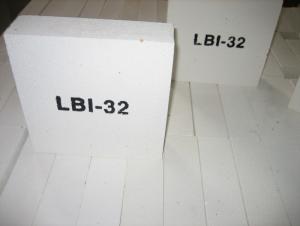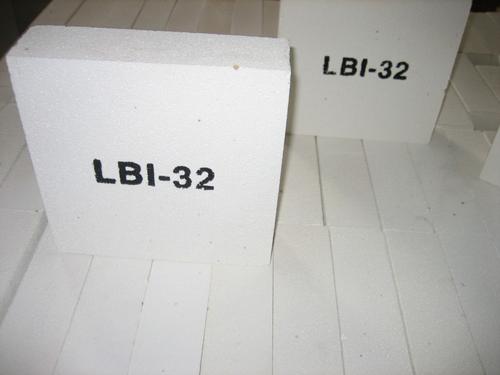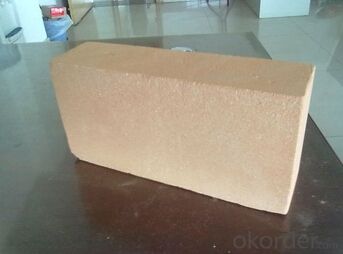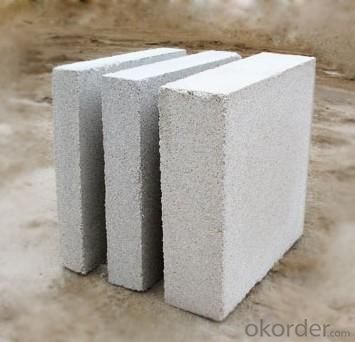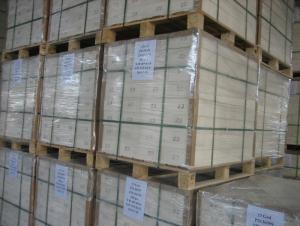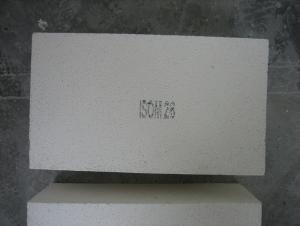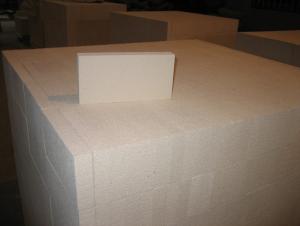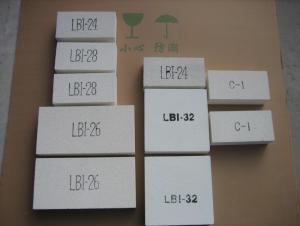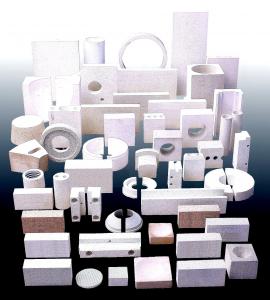Insulating Fire Brick - Refractory Mullite Insulating Refractory Brick JM 28
- Loading Port:
- Shanghai
- Payment Terms:
- TT OR LC
- Min Order Qty:
- 20 m.t.
- Supply Capability:
- 20 m.t./month
OKorder Service Pledge
OKorder Financial Service
You Might Also Like
General Information
CMAX insulating firebricks are classified under temperature between 1300℃ to 1700℃, manufactured from high purity alumina clay.
1. Lower content of iron, alkaline and impurities, good high temperature properties.
2. Homogeneous structure, light weight, energy saving because lower heat storage in the furnace during cooling cycles.
3. High strength, good thermal shock resistance under high temperature.
4. Precise sizes due to grinding and shaping after sintering, which meets the requirement of construction.
5. Max service temp: Up to 1730C (3160F)
Feature
Light weight and low thermal conductivity
Low heat storage
Low iron and impurities
High thermal shock resistance
Application of Insulating brick
Metallurgical Industry: blast furnace, hot blast furnace, heating furnace, etc..
Petrochemical Industry: ethylene cracking furnace, hydrogen furnace, the main furnace, heating furnace, etc..
Ceramic industry: roller kiln, kiln, etc..
Glass industry: glass furnace regenerator, etc.
Carbon industry: carbon furnace, etc..
Aluminum electrolysis industry: aluminum reduction cell, etc.
Other industries: tunnel kiln, shuttle kiln, etc.
Advantages of heat insulation brick
Low thermal conductivity: many air holes will bring good thermal insulation effect, energy saving.
High crushing strength: high crushing strength, volume stability.
Low heat storage: small heat storage, absorb more heat, energy-saving effect is obvious.
Technical Data
ITEM | GJM30 | GJM28 | GJM26 | GJM23 |
Classification Temperature, ℉/℃ | 3000/1650 | 2800/1540 | 2600/1430 | 2300/1260 |
Bulk Density,g/cm³ | ≤1.0 | ≤0.9 | ≤0.8 | ≥0.5 |
Reheating Linear Change, % | ≤0.9 (1550℃,12 h) | ≤0.8 (1510℃,12 h) | ≤0.7 (1410℃,12 h) | ≤0.5 (1230℃,12 h) |
Al2O3 Content, % | ≥75 | ≥65 | ≥55 | ≥45 |
Fe2O3 Content, % | ≤0.5 | ≤0.6 | ≤0.7 | ≤1.0 |
Thermal Conductivity: | ||||
800℃, w/m.k | ≤0.39 | ≤0.37 | ≤0.35 | ≤0.18 |
1000℃, w/m.k | ≤0.43 | ≤0.41 | ≤0.39 | ≤0.20 |
1200℃, w/m.k | ≤0.48 | ≤0.46 | ≤0.43 | --- |
Insulating brick
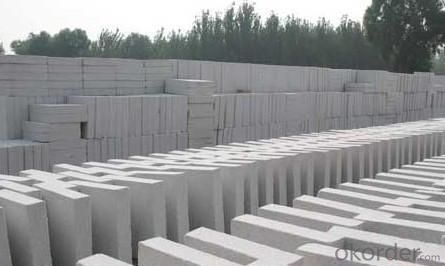
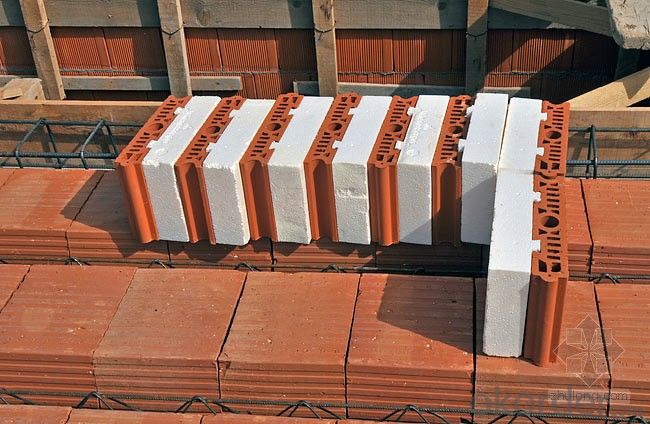
Common problem solution
1. What products do you have?
We have all kinds of refractory bricks, refractory casting materials, mortar, cement, ceramic fiber products, etc..
Or you can browse our products to choose what you need.
2. How to control product quality?
With strict quality control system throughout the material selection and production process, we have the quality of refractory materials and ceramic fiber products to meet customer requirements.
From the selection of raw materials, the quality of our control to start. The quality of the raw materials required for each batch of products in the use of the front line test. In the production process, through the quality control of workers, and then to each piece of classification, and through quality supervision and inspection.
3. Could you give me a brief introduction to the application of your product?
My Company is mainly engaged in steel, cement, glass, ceramics, petrochemical, electric power and other industries.
4. If I need you, what kind of information do you need?
In order to select the right products, we will provide us with information, such as the United States, technical data, order quantity, product applications, etc..
If you have any questions, please contact us.
- Q: Can insulating fire bricks be used in the construction of kilns?
- Insulating fire bricks have the ability to be utilized in the construction of kilns. With a focus on possessing a high insulating value, these bricks can endure high temperatures while minimizing heat loss. This attribute renders them well-suited for the task of kiln construction as they effectively preserve and regulate the desired temperature within the kiln. Furthermore, these bricks are lightweight and easily manageable, adding to their convenience in kiln construction. An additional advantage lies in their resistance to thermal shock, an imperative characteristic for kilns that experience swift temperature fluctuations. In general, insulating fire bricks are a favored option for kiln construction due to their insulating properties, durability, and user-friendliness.
- Q: Can insulating fire bricks be used as a heat shield?
- Yes, insulating fire bricks can be used as a heat shield. They have excellent thermal insulation properties and can withstand high temperatures, making them an ideal choice for protecting against heat radiation and transferring minimal heat to the surrounding areas.
- Q: Are insulating fire bricks suitable for insulation in refinery heaters?
- Insulating fire bricks are indeed suitable for insulation in refinery heaters. These heaters operate at extremely high temperatures, and the insulating fire bricks are specifically designed to withstand these temperatures and provide efficient insulation. With their low thermal conductivity, these bricks effectively prevent heat from escaping the heater, thereby reducing energy loss and improving the overall efficiency of the heater. Moreover, these bricks possess exceptional thermal shock resistance, enabling them to endure sudden temperature changes without cracking or breaking. Given the frequent temperature fluctuations experienced by refinery heaters, this quality is essential. Furthermore, the lightweight nature and easy installation process of insulating fire bricks make them a convenient choice for insulation in refinery heaters. Ultimately, insulating fire bricks prove to be an appropriate and efficient option for insulation in refinery heaters.
- Q: Advantages and disadvantages of external formwork and self thermal insulation block
- Exterior wall insulation form, single material thermal insulation exterior wall: aerated concrete, sintered insulation brick compound thermal insulation exterior wall:According to the different settings of thermal insulation materials, it can be divided into internal insulation, external insulation and sandwich insulation exterior wall. Thermal insulation decorative integrated board: Other: thermal insulation block, etc..
- Q: Are insulating fire bricks resistant to insect infestations?
- While insulating fire bricks are primarily designed to offer exceptional thermal resistance, they do not possess specific features to combat insect infestations. Nevertheless, owing to their dense and sturdy composition, these bricks can serve as a physical barrier against insects, rendering it arduous for them to infiltrate or burrow into the bricks. Moreover, the elevated temperatures that insulating fire bricks can endure might discourage insects from nesting or infesting them. Nevertheless, it is crucial to acknowledge that no material is entirely impervious to insect infestations, and if there exist any cracks or gaps within the bricks, insects may still find their way inside. Conducting regular inspections and maintenance is indispensable to ensure the integrity of the bricks and preempt any prospective insect infestations.
- Q: Are insulating fire bricks resistant to sound transmission?
- Insulating fire bricks, which are also known as refractory bricks, are primarily designed to withstand high temperatures and provide thermal insulation. Despite their effectiveness in reducing heat transfer, they are not specifically engineered to resist sound transmission. The composition of insulating fire bricks consists of materials like clay, alumina, and silica, carefully selected for their ability to withstand high temperatures. These materials possess density and low porosity, which aids in blocking the passage of heat through the bricks. However, solid materials, including insulating fire bricks, allow sound waves to easily pass through unless additional measures are taken to mitigate sound transmission. To effectively minimize sound transmission, it is advisable to employ other soundproofing techniques in conjunction with insulating fire bricks. These methods may involve incorporating additional layers of acoustic insulation or utilizing sound barriers like mass-loaded vinyl or acoustic panels. In summary, while insulating fire bricks excel in providing thermal insulation, they do not possess inherent resistance to sound transmission. To efficaciously minimize noise transmission within a given area, supplementary soundproofing measures should be implemented.
- Q: Can insulating fire bricks be used in wood-fired kilns?
- Yes, insulating fire bricks can be used in wood-fired kilns. These bricks are designed to withstand high temperatures and provide excellent insulation, making them ideal for wood-fired kilns. They help to retain heat and distribute it evenly throughout the kiln, ensuring efficient and consistent firing of the wood. Additionally, insulating fire bricks are lightweight, which can aid in the construction and maintenance of the kiln. Overall, using insulating fire bricks in wood-fired kilns can enhance their performance and efficiency.
- Q: Can insulating fire bricks be used in ceramic fiber boards?
- Yes, insulating fire bricks can be used in ceramic fiber boards. Insulating fire bricks are commonly used as a lining material for high-temperature applications, as they are able to withstand very high temperatures and provide excellent thermal insulation. Ceramic fiber boards, on the other hand, are lightweight and have good thermal shock resistance, making them suitable for use in various industrial and residential settings. When used together, insulating fire bricks can be placed behind or around the ceramic fiber boards to enhance their insulating properties and increase overall thermal efficiency. The bricks can provide additional structural support and help to retain heat within the system, improving energy efficiency and reducing heat loss. However, it is important to note that the compatibility of insulating fire bricks and ceramic fiber boards may vary depending on the specific application and requirements. It is recommended to consult with manufacturers or industry experts to ensure proper selection and installation of these materials for your specific needs.
- Q: Can fly ash brick keep warm?
- Add blocks and have autoclaved fly ash bricks, do not you?
- Q: Can insulating fire bricks be recycled?
- Yes, insulating fire bricks can be recycled. These bricks are typically made from a combination of materials such as clay, alumina, and silica, which can be broken down and reused. Recycling insulating fire bricks involves crushing them into smaller pieces and then using them as aggregate in various construction applications. This process helps to reduce waste and conserve resources, making it an environmentally friendly option for disposing of these bricks. Additionally, some companies offer recycling programs specifically for insulating fire bricks, allowing individuals and businesses to easily recycle them instead of sending them to landfills.
Send your message to us
Insulating Fire Brick - Refractory Mullite Insulating Refractory Brick JM 28
- Loading Port:
- Shanghai
- Payment Terms:
- TT OR LC
- Min Order Qty:
- 20 m.t.
- Supply Capability:
- 20 m.t./month
OKorder Service Pledge
OKorder Financial Service
Similar products
Hot products
Hot Searches
Related keywords
